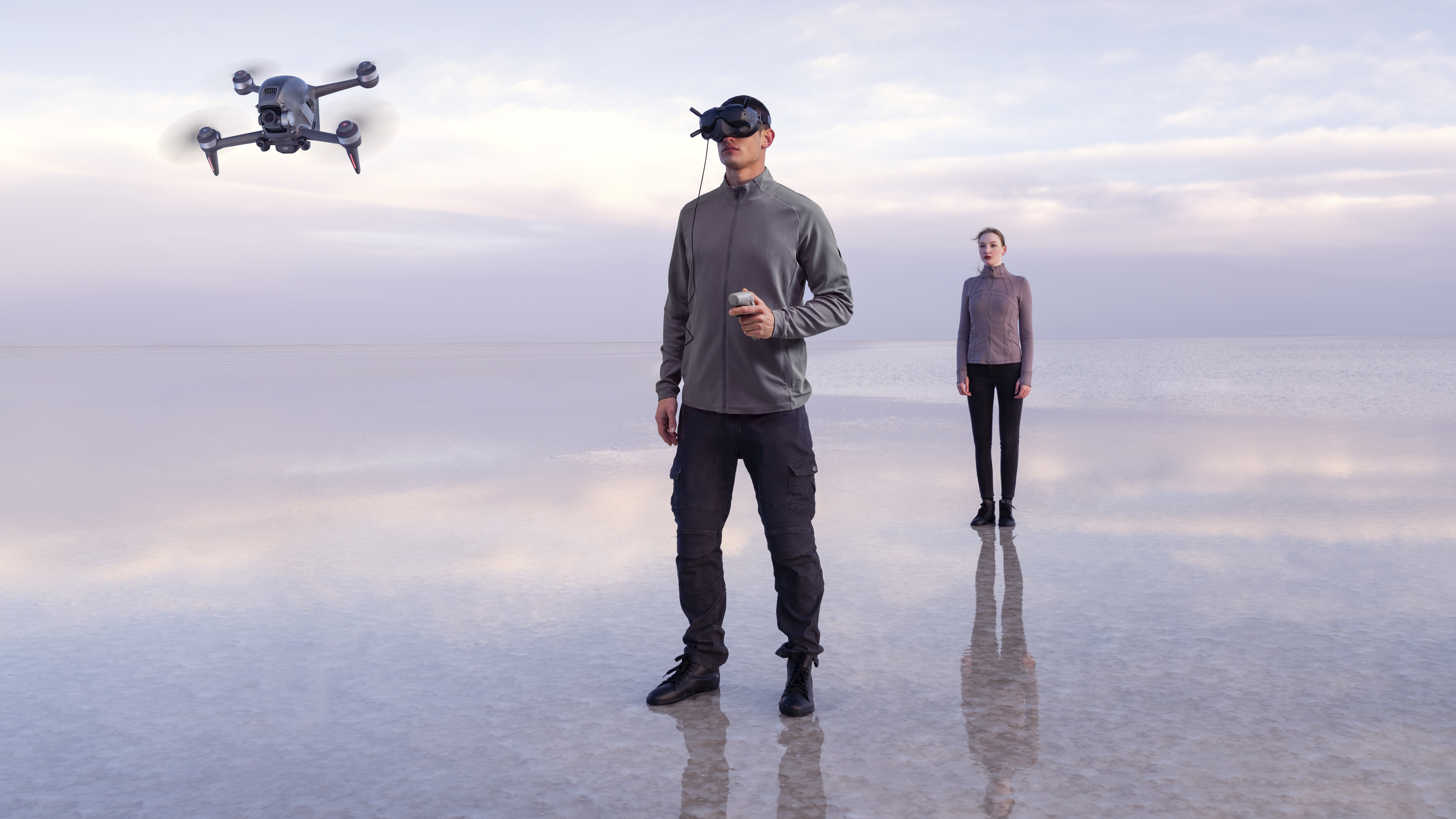What we expect from camera drones in 2022 (and what the regulators will allow…)
The ever-changing world of camera drones promises more in 2022 than before, in terms of tech and the battle to use it

Arguably, drones as we know them were born at CES 2010. Apple’s App Store hadn’t celebrated its second birthday, and the Parrot AR Drone took advantage of it to put a quadcopter’s controls – and video output – in the hand. In that time, we’ve seen a lot of change, fast. Sports, photography, videography, delivery and more have all been affected by quadcopters alone, even ignoring the wider definition of the word ‘drone’ to mean any remotely controlled aircraft.
• Read more: Best camera drones • Best thermal drones
The pace of change doesn’t seem to be slowing either; if anything the tight restrictions from regulators like the FAA and CAA – which didn’t go down well at first – have only driven more developments faster. So what’s coming next? We’ll get to some specific models in a bit, but first some wider trends:
Drone delivery (yes, we know) rules, and reality
The prospect of drone delivery is one which raises groans amongst long term industry watchers, but it might really be a thing in 2022, but it still won’t be Amazon Prime Air (which is only delivering redundancies, and over 100 of them).
Instead a company called Manna have created a platform comparable in experience to Deliveroo or Just Eat and it is in operation already in Galway. The drones are piloted autonomously with an average delivery time of under 3 minutes. One operator at the base monitors up to 20 aircraft at a time. From there the company will be able to expand to European countries and – soon – Canada, though they say the FAA’s regulatory structure poses more issues.
That hasn’t stopped North-Carolina based firm Flytrex get an extra mile (10,000 homes) added to their trial zone. With a similar model – partnering with food delivery – the firm has been able to deliver up to eight hamburgers per flight and has found the pandemic has driven demand.
More importantly for the wider world, the company has been working with the FAA as they develop the rules on Unmanned Traffic Management (UTM), and UTM is something all drone pilots – especially photographers and videographers – will need to keep a close eye on. Why? Because the business world really is looking at filling skies with delivery bots and flying taxis; Joby aviation has already carried out 1,000 test flights of their Jetsons-like electric flying taxi, and are aiming at getting FAA approval in 2024 to begin commercial service from city centre locations like adapted roofs and carparks.
The best camera deals, reviews, product advice, and unmissable photography news, direct to your inbox!
In the UK, too, plans have been approved to build the first Urban Air Port in Coventry (with the backing of car manufacturer Hyundai). The first test flights should begin in 2022.
All this means that both sides of the Atlantic drone pilots are now squaring off against not just the exaggerated safety fears of technophobes, but the interests of large-scale commercial use. The difference is that UTM should mean pilots can claim airspace at the push of a button – of the last 120m (400ft) of airspace, which is why UTM will be a growing issue. Expect to hear more about both an Open UTM Service standard being finalized.
Drone over cellular
Expect to see a growing fight over a potentially useful tech; drone over 4G / LTE. DJI offer a 4G dongle for their new Mavic 3, and the previously-announced Parrot Anafi AI uses built-in 4G connectivity to support BVLOS (Beyond Visual Line of Sight) operation. Both aircraft have obstacle avoidance systems which allow them to plot more efficient routes to continue their mission (or RTH, in the Mavic’s case).
4G’s advantage is the transmission at relatively low frequency bands, for longer range; there are obvious advantages for services like first responders keen to get an eye on the ground before vehicles can get to a scene. There are also potential advantages for the drone supplier; Anafi AI users add a 4G SIM and their communication takes place via an encrypted cloud Parrot operate. Not only should we expect to see more servers like this in the future, but it’s worth remembering that a lot of cloud operations make a tidy profit on the subscriptions.
The under 250g category

Autel’s announcement of their EVO Nano drone – under 250g and sporting a 48-megapixel camera with 0.8-inch sensor – suggests real competition in the low weight category. Admittedly it’s not news; the drone was announced back in September, but still hasn’t been seen out in the wild (a cynic might note that the timing conflicted with some of DJI’s announcements).
Whatever the reason, Autel have a history of early announcements and shipping delays, but industry-watches now expect the Nano will ship in February 2022, giving it a couple of months lead time against… well… keep reading.
DJI drones coming in 2022
As the dominant brand in the drone world, DJI’s product pipeline is always of interest. With the previous hot topic, the Mavic 3, finally been revealed (and especially once it finally gains ActiveTrack in the promised January firmware update), what else is to come?
According to a leaked roadmap, the next new drone will be a new Mini 3 around April 2022; that makes sense as the Mini line has received regular updates since its inception, in part because of the higher level of competition in the sub-250g consumer market. We’re hoping to see some collision sensors introduced.
There is also the possibility of an FPV Mini, which would be an interesting prospect. The company's first foray into this market, the DJI FPV, while an excellent device, has a price which represents too high a hurdle for many and a heft which makes play feel risky. A smaller, lighter version of this – learning something from the “cinewhoop” enthusiast drones – could have a much wider appeal.
The other drone on the leaked plan – albeit toward the end of 2022 – is the Inspire 3. The Inspire 2 was announced in late 2016, so there is a lot which could be updated in the airframe, but it’s worth remembering the camera is a separate detachable unit which hangs below the drone itself and can rotate independently. DJI have maintained and updated the Zenmuse camera series – which can also be paired with the enterprise class Matrice series, and many pros would probably be keen not to update their cameras or lenses.
It seems implausible that the iconic bird-of-prey design will be dropped, but the flying crane is in need of more modern radio control and better battery life (the current 23 minute flight time with Zenmuse X7 camera compares poorly with a Mavic 3). Will that mean the weighty, pricey TB50 battery system is due a refresh? Hopefully. The pilot’s FPV camera would benefit from better resolution and a larger sensor, and rear collision sensors would be expected as a minimum. The drone can already achieve a thumping 67mph, but this might improve; we can’t imagine the takeoff weight being much below the existing 4250g. If the same shell is kept, hopefully the natural lifting point at the arch of the fuselage won’t be sharp enough to slice a finger.
On a slightly worrying note for the firm, DJI will also have to face the implications of having been added to an investment and export blacklist by the US Department of Commerce; this follows being added to the US Treasury’s “Chinese military-industrial complex companies” blacklist. While US investors will be barred from taking a stake in DJI, what any of this actually means is open to debate; other firms on the list have had to delay their IPO, but DJI’s cash is already flowing and there doesn’t seem to be any immediate risk of the products disappearing from the shelves in the US or elsewhere. It might go toward explaining the upward trajectory in pricing though.
USA and Europe/UK rules in flux
The only constant here is change, but the FAA have been taking a look at AC 91-57C, the document which allows recreational operation, having accepted comments last summer; this pending update to the existing FAA rules (which have been in place since May 2019).
Remote ID is coming to drones September 2022, but the deadline for pilots won’t be until the same time in 2023; a Remote ID drone will be capable of broadcasting the drone’s (and, by extension, user’s) ID, location, altitude, location of operator and whether or not it has declared an emergency.
In the EU & UK, many drone pilots will be seeking an A2 Certificate of Competence as so-called “Legacy Drones” – including popular models above 250g like the Mavic series – will need this qualification to be flown within 150m (500ft) of a congested area. The new weight tiers are fully in force by the end of 2022, and even now you need to get your flyer ID before you start flying outdoors (see the CAA site).
Read more:
• Best camera drones
• Best drones for beginners
• Best cheap drones
• Drone rules: US, UK and beyond
• Best underwater drones
• Best drone accessories
• Best drones for kids
• Best FPV drones
• Best indoor drones for fun

With over 20 years of expertise as a tech journalist, Adam brings a wealth of knowledge across a vast number of product categories, including timelapse cameras, home security cameras, NVR cameras, photography books, webcams, 3D printers and 3D scanners, borescopes, radar detectors… and, above all, drones.
Adam is our resident expert on all aspects of camera drones and drone photography, from buying guides on the best choices for aerial photographers of all ability levels to the latest rules and regulations on piloting drones.
He is the author of a number of books including The Complete Guide to Drones, The Smart Smart Home Handbook, 101 Tips for DSLR Video and The Drone Pilot's Handbook.



